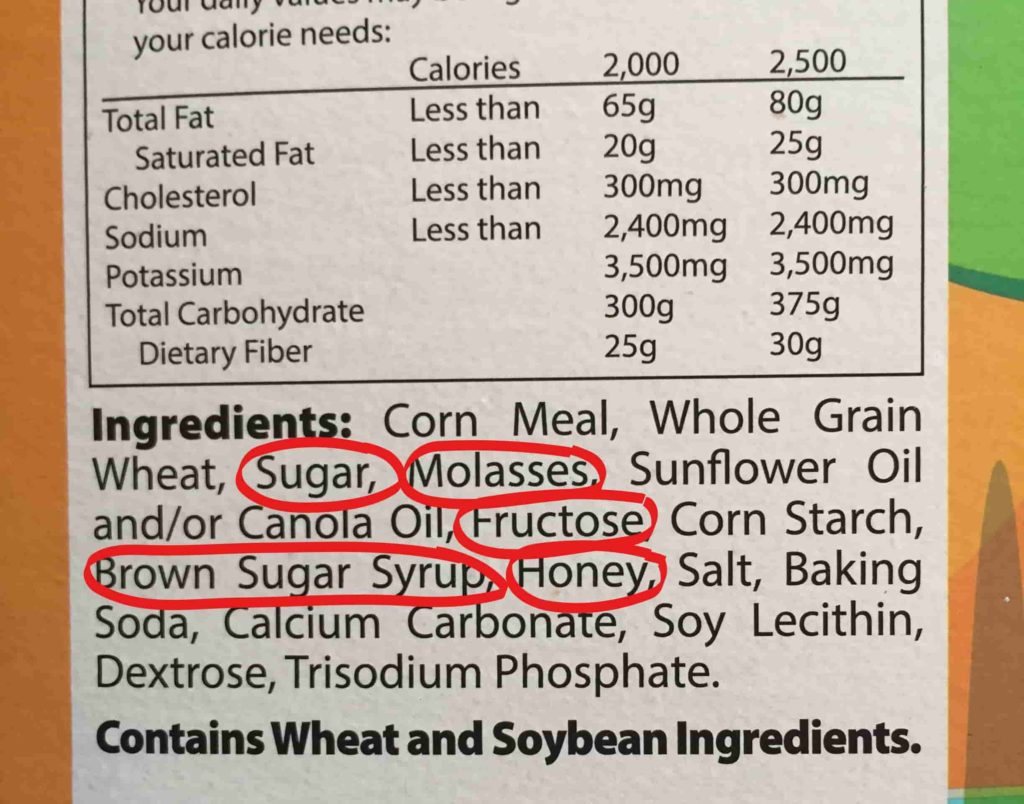Unmasking sugar is crucial to a healthier lifestyle, as excessive sugar consumption is linked to numerous health problems, such as obesity, heart disease, and diabetes. The food industry often employs sophisticated strategies to include sugar in their products without explicitly mentioning it. Here are 99 ways the food industry hides sugar, each backed by science.

Alias Sugar
Sugar can take many forms, and knowing these aliases is the first step in identifying hidden sugars in food products. Here are some of them:
Certainly, it’s important to understand these forms of sugar and sugar alternatives to make informed dietary choices.
- Sucrose: Commonly known as table sugar, it is a disaccharide composed of glucose and fructose. It’s derived from sugar beet or sugar cane [1].
- Glucose: A simple sugar or monosaccharide that is the main source of energy for the body’s cells [2].
- Fructose: A monosaccharide found in many fruits and vegetables. It is also a component of high-fructose corn syrup and table sugar [3].
- Dextrose: Another name for glucose, often used in baking and in medical contexts [4].
- Maltose: A disaccharide composed of two glucose units, found in malted grains [5].
- Galactose: A monosaccharide that combines with glucose to form lactose, the sugar found in milk [6].
- High Fructose Corn Syrup (HFCS): A sweetener made from corn starch, it has a high fructose-glucose ratio, making it sweeter than table sugar [7].
- Agave Nectar: A sweetener produced from several species of agave. It is sweeter than sugar and has a lower glycemic index [8].
- Cane Sugar: Sucrose derived from sugar cane [9].
- Cane Juice: The liquid extracted from sugar cane during the sugar-making process [10].
- Raw Sugar: Also known as turbinado sugar, is minimally processed sugar cane extract [11].
- Brown Sugar: Sucrose with molasses added back after processing gives it a darker color and distinct flavour [12].
- Beet Sugar: Sucrose derived from sugar beets [13].
- Coconut Sugar: Made from the sap of the coconut palm, it has a lower glycemic index than table sugar [14].
- Palm Sugar: Similar to coconut sugar, but made from a different species of palm tree [15].
- Date Sugar: Made from dried dates, it retains the fruit’s fiber content but is not as sweet or as easily dissolved as other sugars [16].
- Honey: A natural sweetener produced by bees from the nectar of flowers. It contains a mix of sugars, mainly fructose and glucose [17].
- Molasses: A byproduct of sugar production, it is a thick, dark syrup with a robust flavour [18].
- Sorghum Syrup: Made from the sweet juice of the sorghum plant, this syrup has a unique, somewhat sour flavour [19].
- Maple Syrup: A sweetener made from the sap of maple trees [20].
- Corn Syrup: A liquid sweetener made from cornstarch, it contains varying amounts of maltose and higher glucose [21].
- Corn Syrup Solids: Dehydrated corn syrup, used in powdered food products [22].
- Hydrolyzed Starch: A sugar produced by breaking down starch, usually with enzymes or acids [23].
- Evaporated Cane Juice: Essentially another name for raw sugar, it is a less processed form of cane sugar [24].
- Xylose: This is a monosaccharide, or simple sugar, that is not very sweet. It’s often used in the production of xylitol, a sugar alcohol that is used as a low-calorie sweetener [25].
- Malt Syrup: A thick, sweet syrup made from sprouted (malted) barley [26].
- Barley Malt: Also known as malt extract, it’s a sweet, sticky substance used in baking and brewing [27].
- Rice Syrup: A sweetener made from fermented cooked rice, it consists mostly of glucose [28].
- Caramel: Sugar that has been heated until it melts and then cools into a hard, sweet substance [29].
- Carob Syrup: A sweet syrup made from the pods of the carob tree [30].
- Golden Syrup: A light-colored syrup made from refined sugar [31].
- Treacle: A term used in the UK for a syrup that’s similar to molasses [32].
- Turbinado: Another name for raw sugar [33].
- Muscovado: An unrefined brown sugar with a strong molasses flavour [34].
- Demerara Sugar: A type of raw cane sugar with a large grain and a light brown colour [35].
- Panela Sugar: Unrefined whole cane sugar, common in Latin America [36].
- Jaggery: A sweetener made from date, cane juice, or palm sap, commonly used in Asia and Africa [37].
- Rapadura: A Latin American name for unrefined, whole cane sugar [38].
- Sucanat: A brand name for a granulated form of whole, unrefined cane sugar [39].
- Yellow Sugar: A moist sugar, darker and less refined than white sugar, also known as brown sugar [40].
- Florida Crystals: A brand name for a line of organic cane sugars [41].
- Icing Sugar: Also known as powdered sugar or confectioner’s sugar, it is finely ground sucrose, often mixed with a small amount of cornstarch [42].
- Confectioner’s Sugar: Another name for icing sugar [43].
- Powdered Sugar: Another name for icing sugar [44].
- Invert Sugar: A mixture of glucose and fructose, it’s produced by splitting sucrose into these two components [45].
- Maltodextrin: A polysaccharide used as a food additive, produced from vegetable starch [46].
- Dextran: A complex, branched polysaccharide made of glucose molecules [47].
- Ethyl Maltol: A flavour enhancer with a sweet smell, used in some food and e-cigarette products [48].
- Diastatic Malt: Malted (sprouted) grain (usually barley) that has been dried and ground into a powder. It’s used in baking for its enzymes, which can break starch down into sugar [49].
- Maltol: A naturally occurring organic compound that is used primarily for flavour in the food industry [50].
- Mannose: A monosaccharide sugar, it’s less sweet than glucose and may have potential health benefits [51].
- Panocha: In the Philippines, it’s unrefined sugar; in Spain, it’s a type of fudge [52].
- Refiner’s Syrup: A byproduct of sugar refining, similar to molasses [53].
- Syrup: A generic term for a thick, sweet liquid [54].
- Rice Bran Syrup: A sweetener derived from rice bran [55].
- Barbados Sugar: Another term for muscovado sugar [56].
- Buttered Syrup: A syrup often used for flavouring in confectionery [57].
- Caramel Syrup: A syrup made by caramelizing sugar [58].
- Saccharose: This is another scientific name for common table sugar or sucrose [59].
- Turbinado Syrup: A syrup made from turbinado sugar [60].
- Monk Fruit Extract: Derived from monk fruit, this is a natural, zero-calorie sweetener that’s much sweeter than sugar [61].
- Erythritol: A type of sugar alcohol that tastes sweet but doesn’t raise blood sugar levels as much as regular sugar [62].
- Birch Sugar: Another name for xylitol, a sugar alcohol that is as sweet as sugar but has fewer calories [63].
- Glycerol: Also known as glycerin or glycerine, it’s a sugar alcohol that’s sweet but has fewer calories than sugar [64].
- Corn Sweetener: Any sweetener derived from corn, including HFCS and corn syrup [65].
- Crystalline Fructose: A sweetener made by allowing the fructose in corn syrup to crystallize [66].
- Dextrin: A group of low-molecular-weight carbohydrates produced from starch or glycogen [67].
- Sorbitol: A sugar alcohol that is found naturally in fruits, but is also produced synthetically and used as a sweetener [68].
- Dulcitol: A naturally occurring sugar alcohol, less sweet than sugar and not commercially used but still classified as a sugar [69].
- Glucose-fructose syrup: This is another name for high fructose corn syrup used in Europe. It’s made from corn and has a high fructose-glucose ratio. [70].
- Fructooligosaccharides: Short chains of fructose molecules. The body does not digest them, so they act as dietary fibre [71].
- Glucitol: Also known as sorbitol, it’s a sugar alcohol that’s about 60% as sweet as sugar [72].
- Glucosamine: A compound that is part of the structure of cartilage. It’s not sweet, but it’s sometimes classified with sugars because of its structure [73].
- Hexitol: A generic term for any sugar alcohol, a class of sweeteners that includes xylitol, sorbitol, and others [74].
- Inulin: A type of soluble fiber found in many plants. It’s used as a prebiotic and a low-calorie sweetener [75].
- Isomalt: A sugar substitute made from beet sugar. It’s used in sugar-free candies and other sweets [76].
- Lactitol: A sugar alcohol used as a replacement sugar in low calorie and sugar-free foods [77].
- Maltitol: A sugar alcohol used as a sugar substitute because it has half the calories of sugar but retains much of the sweetness [78].
- HSH (Hydrolyzed Starch Hydrolysate): A mixture of several sugar alcohols made by breaking down starch [79].
- Polyglycitol: A mixture of several sugar alcohols [80].
- Ribose Rice Syrup: Rice syrup enriched with the sugar ribose, a component of RNA and other bioactive molecules [81].
- Galactose: A monosaccharide sugar that’s less sweet than glucose and forms part of the disaccharide lactose [82].
- Casienate: Not a sugar but a family of related phosphoproteins commonly found in mammalian milk [83].
- Yellow Sugar: Another term for brown sugar [84].
- Fruit Juice: Liquid extracted from fruits [85].
- Fruit Juice Concentrate: Fruit juice from which most of the water has been removed [86].
- Dehydrated Cane Juice: A less processed form of cane sugar that retains some trace nutrients [87].
- Cane Juice Crystals: Another term for granulated sugar [88].
- Tagatose: A sweetener that’s chemically similar to fructose but has fewer calories [89].
- Malt Powder: Ground, malted grain, used as a sweetener and flavouring agent in baking [90].
- Diatase: An enzyme that breaks down starch into maltose [91].
- Disaccharides: Any sugar composed of two monosaccharides, including sucrose, lactose, and maltose [92].
- Isoglucose: This is another term for high-fructose corn syrup, a sweetener made from corn starch and commonly found in various food and drink products [93].
- Glucose Syrup Solids: This is a dried form of glucose syrup, and can be used as a sweetener or texture enhancer in a variety of food products [94].
- Fruit Syrup: This is a type of sweetener derived from fruits. Despite the healthy-sounding name, fruit syrups are still a form of added sugar [95].
- Blackstrap Molasses: This is a byproduct of sugar cane’s refining process. While it is slightly better than raw sugar because of its small mineral content, it is still a form of sugar [96].
- Syrup Solids: This is another name for dehydrated syrup, which can be made from a variety of sources, including corn, maple, and cane sugar [97].
- Organic Raw Sugar: Despite the term “organic,” this is still a type of sugar. It is slightly less processed than regular table sugar, but still has similar effects on blood glucose levels [98].
- Tapioca Syrup: This is a sweetener derived from the cassava plant. It is less sweet than sucrose and often used as a substitute for corn syrup [99].
Wrapping Up
While the list is extensive, it’s important to note that all these sugar forms have similar effects on the body. They increase blood glucose levels, potentially leading to insulin resistance and other metabolic disturbances if consumed excessively.
In conclusion, being knowledgeable about the different names of sugar and being cautious while reading food labels can help one avoid hidden sugars and maintain a healthier diet.







